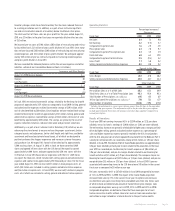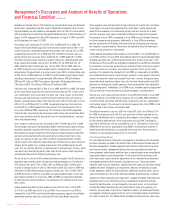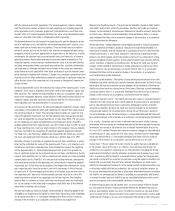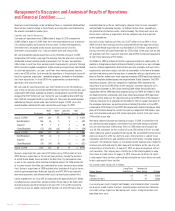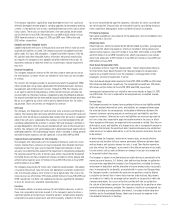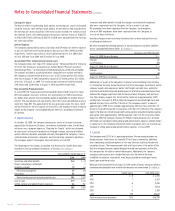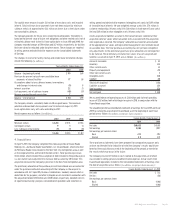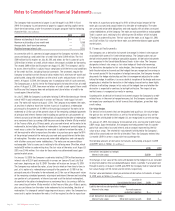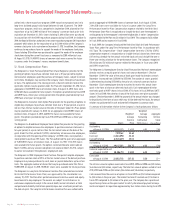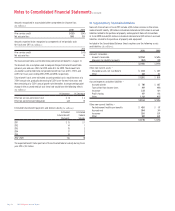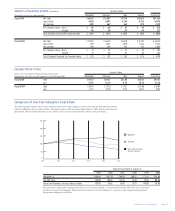Walgreens 2010 Annual Report Download - page 31
Download and view the complete annual report
Please find page 31 of the 2010 Walgreens annual report below. You can navigate through the pages in the report by either clicking on the pages listed below, or by using the keyword search tool below to find specific information within the annual report.losses are recorded based upon the Company’s estimates for claims incurred and
are not discounted. The provisions are estimated in part by considering historical
claims experience, demographic factors and other actuarial assumptions.
Pre-Opening Expenses
Non-capital expenditures incurred prior to the opening of a new or remodeled store
are expensed as incurred.
Advertising Costs
Advertising costs, which are reduced by the portion funded by vendors, are expensed
as incurred. Net advertising expenses, which are included in selling, general and
administrative expenses, were $271 million in fiscal 2010, $334 million in fiscal 2009
and $341 million in fiscal 2008. Included in net advertising expenses were vendor
advertising allowances of $197 million in fiscal 2010, $174 million in fiscal 2009 and
$180 million in fiscal 2008.
Stock-Based Compensation Plans
In accordance with ASC Topic 718, Compensation — Stock Compensation (formerly
SFAS No. 123(R), Share-Based Payment), the Company recognizes compensation
expense on a straight-line basis over the employee’s vesting period or to the
employee’s retirement eligible date, if earlier.
Total stock-based compensation expense for fiscal 2010, 2009 and 2008 was $84 million,
$84 million and $68 million, respectively. The recognized tax benefit was $29 million,
$29 million and $23 million for fiscal 2010, 2009 and 2008, respectively.
Unrecognized compensation cost related to non-vested awards at August 31, 2010,
was $89 million. This cost is expected to be recognized over a weighted average
of three years.
Income Taxes
The Company accounts for income taxes according to the asset and liability method.
Under this method, deferred tax assets and liabilities are recognized based upon
the estimated future tax consequences attributable to differences between the
financial statement carrying amounts of existing assets and liabilities and their
respective tax bases. Deferred tax assets and liabilities are measured pursuant to
tax laws using rates expected to apply to taxable income in the years in which
those temporary differences are expected to be recovered or settled. The effect on
deferred tax assets and liabilities of a change in tax rate is recognized in income in
the period that includes the enactment date. Valuation allowances are established
when necessary to reduce deferred tax assets to the amounts more likely than not
to be realized.
In determining the Company’s provision for income taxes, an annual effective
income tax rate based on full-year income, permanent differences between book
and tax income, and statutory income tax rates is used. The effective income tax
rate also reflects the Company’s assessment of the ultimate outcome of tax audits.
Discrete events such as audit settlements or changes in tax laws are recognized
in the period in which they occur.
The Company is subject to routine income tax audits that occur periodically in the
normal course of business. U.S. federal, state and local and foreign tax authorities
raise questions regarding the Company’s tax filing positions, including the timing
and amount of deductions and the allocation of income among various tax jurisdic-
tions. In evaluating the tax benefits associated with its various tax filing positions,
the Company records a tax benefit for uncertain tax positions using the highest
cumulative tax benefit that is more likely than not to be realized. Adjustments
are made to its liability for unrecognized tax benefits in the period in which the
Company determines the issue is effectively settled with the tax authorities,
the statute of limitations expires for the return containing the tax position or when
more information becomes available. The Company’s liability for unrecognized tax
benefits, including accrued penalties and interest, is included in other long-term
liabilities on the Consolidated Balance Sheets and in income tax expense in the
Consolidated Statements of Earnings.
The Company capitalizes application stage development costs for significant
internally developed software projects, including upgrades to merchandise ordering
systems, a store point of sale system, a workload balancing system, and an adver-
tising system. These costs are amortized over a five-year period. Amortization
was $44 million in fiscal 2010, $40 million in fiscal 2009 and $36 million in fiscal
2008. Unamortized costs at August 31, 2010 and 2009, were $244 million and
$202 million, respectively.
Goodwill and Other Intangible Assets
Goodwill represents the excess of the purchase price over the fair value of assets
acquired and liabilities assumed. The Company accounts for goodwill and intan-
gibles under ASC Topic 350, Intangibles — Goodwill and Other (formerly SFAS No.
142, Goodwill and Other Intangible Assets), which does not permit amortization,
but requires the Company to test goodwill and other indefinite-lived assets for
impairment annually or whenever events or circumstances indicate impairment
may exist.
Revenue Recognition
The Company recognizes revenue at the time the customer takes possession of
the merchandise. Customer returns are immaterial. Sales taxes are not included
in revenue.
The services the Company provides to our pharmacy benefit management (PBM)
clients include: plan set-up, claims adjudication with network pharmacies, formulary
management, and reimbursement services. Through its PBM, the Company acts
as an agent in administering pharmacy reimbursement contracts and does not
assume credit risk. Therefore, revenue is recognized as only the differential between
the amount receivable from the client and the amount owed to the network pharmacy.
We act as an agent to our clients with respect to administrative fees for claims
adjudication. Those service fees are recognized as revenue.
Gift Cards
The Company sells Walgreens gift cards to retail store customers and through its
website. The Company does not charge administrative fees on unused gift cards and
most gift cards do not have an expiration date. Income from gift cards is recognized
when (1) the gift card is redeemed by the customer; or (2) the likelihood of the gift
card being redeemed by the customer is remote (“gift card breakage”) and there is
no legal obligation to remit the value of unredeemed gift cards to the relevant juris-
dictions. The Company’s gift card breakage rate is determined based upon historical
redemption patterns. Gift card breakage income, which is included in selling, general
and administrative expenses, was not significant in fiscal 2010, 2009 or 2008.
Impaired Assets and Liabilities for Store Closings
The Company tests long-lived assets for impairment whenever events or circum-
stances indicate that a certain asset may be impaired. Store locations that have
been open at least five years are reviewed for impairment indicators at least
annually. Once identified, the amount of the impairment is computed by comparing
the carrying value of the assets to the fair value, which is based on the discounted
estimated future cash flows. Impairment charges included in selling, general and
administrative expenses were $17 million in fiscal 2010, $10 million in fiscal 2009
and $12 million in fiscal 2008.
The Company also provides for future costs related to closed locations. The liability
is based on the present value of future rent obligations and other related costs
(net of estimated sublease rent) to the first lease option date. The reserve for
store closings was $151 million, $99 million and $69 million in fiscal 2010, 2009 and
2008, respectively. See Note 3 for additional disclosure regarding the Company’s
reserve for future costs related to closed locations.
Insurance
The Company obtains insurance coverage for catastrophic exposures as well as
those risks required by law to be insured. It is the Company’s policy to retain a
significant portion of certain losses related to workers’ compensation, property,
comprehensive general, pharmacist and vehicle liability. Liabilities for these
2010 Walgreens Annual Report Page 29


